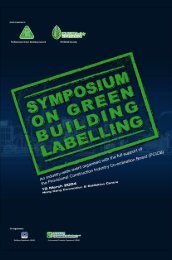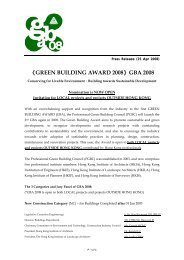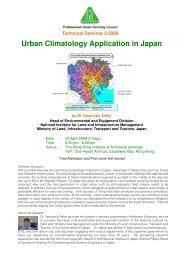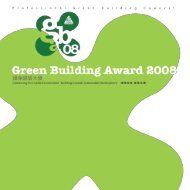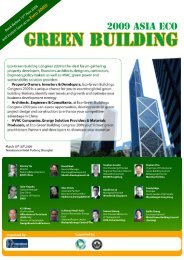10th Anniversary Booklet - The Professional Green Building Council
10th Anniversary Booklet - The Professional Green Building Council
10th Anniversary Booklet - The Professional Green Building Council
Create successful ePaper yourself
Turn your PDF publications into a flip-book with our unique Google optimized e-Paper software.
categorical values taken account into the natural growth habit, form ofplants, variations in plant age and landscape uses. <strong>The</strong> summarized LAI andcanopy area values are shown in the following table.Plant GroupLAISub-CategoriesLAIValue to Use Canopy Area to Use (m 2 )Trees Dense Canopy 4.0 Girth 1.5m : 150(Girth refers to trunkcircumference at height of1m from ground)Palms Solitary 2.5 20Cluster 4.0 17Shrubs Monocot 3.5 Planted areaDicot 4.5 Planted areaTurfs Nil 2.0 Planted area<strong>The</strong> calculation of GnPR in a site can be carried out by (1) collecting theinformation on site area, number of trees (and their girth sizes), palms andplanted areas for shrubs and turfs, (2) determine the LAI sub-categories ofthe plants with reference to the database in the website of National Parks(NParks), (3) computing the total leaf area by summing up the leaf area foreach plants species and (4) dividing the total leaf area by site area to obtainGnPR in a site.Adoption of <strong>Green</strong>ery Coverage Requirements in Hong KongIn Hong Kong, the <strong>Council</strong> for Sustainable Development (SDC) publishedthe “Report on the Public Engagement Process on <strong>Building</strong> Design to Fostera Quality and Sustainable Built Environment” in June 2010 upon extensivepublic consultations and discussions with professional organizations, greengroups, councilors and relevant key stakeholders. <strong>The</strong> SDC recommendedthe minimum requirement to provide greenery for sites no less than1,000m 2 in new building developments or redevelopments with fixedplanting areas of 20% to 30% of the site areas.Following SDC’s recommendation for greening provision, the Governmentof Hong Kong SAR issued “Development Bureau Technical Circular (Works)No. 3/2012 – Site Coverage of <strong>Green</strong>ery for Government <strong>Building</strong> Projects”in 2012 which sets out the standards and requirements on greenerycoverage for new government buildings. This requires the minimum sitecoverage of greenery of 30% for site area equal or above 20,000m 2 and 20%for site area between 1,000m 2 and 20,000m 2 . As planting at grade withindevelopment provides a more natural condition for plant establishmentand improves the setting at street level, the Technical Circular also requiresat-grade greenery area should not be less than 50% of the minimumsite coverage of greenery requirements. <strong>The</strong> greenery coverage ofminimum 30% site area is also recommended for both public and privatedevelopments in the Kai Tak Development located at the former Hong KongKai Tak International Airport.<strong>The</strong> calculation of site coverage of greenery under the Technical Circularis a two dimensional approach which is relatively simple and direct. It isbased on the horizontal soil areasfor planting and this includessoil areas at-grade, on podiumand roof levels. <strong>The</strong> TechnicalCircular defines the calculationbasis of site area and countableareas for greenery. For specialgreenery provision such as verticalgreening, greening on slopes andcovered greenery areas, the totalcountable areas for inclusion inthe calculation of greenery iscapped at 30%. Priority is given forat grade-tree planting for optimalgreening effect.<strong>The</strong> same greenery coveragerequirements with similarcalculation basis are also appliedfor non-government buildingdevelopments under “PracticeNote for Authorized Persons,Registered Structural Engineersand Registered GeotechnicalEngineers – APP 152”. Through thevetting of landscape design by planning and lease controls, a balance mix oftrees and other plant types can be provided in a development to achieve aquality green setting. With the join effort from the public and private sectors,a greener built environment in Hong Kong is anticipated in the coming decade.Concluding Remarks<strong>The</strong> greening requirements should be adequately addressed at planningand design stages so that the greenery can be smoothly integrated withthe buildings to facilitate management to achieve the goals in landscapedesign. <strong>The</strong> quantitative approach stipulates clear requirements in greeningprovision for building developments. Continual improvements on thequantitative approach are required to yield a more thorough, practicaland sustainable methodology to cater for different land uses. Yet, qualitylandscape design and management are equally important to address thesafety, aesthetic, functional and maintenance concerns in the green setting.It is hoped that both quantitative and qualitative development in greeningcan lead to a safer, greener and more sustainable built environment.Simon NGHKILA RepresentativeFigure 2: <strong>The</strong> Central Government Offices inHong Kong has greenery coverage of over35% site area. This provides a pleasant andgreen outdoor setting to ameliorate builtenvironment. (Photo: Architectural ServicesDepartment, HKSAR)ReferencesChiang K. and Tan A. (2009). Vertical <strong>Green</strong>ery for the Tropics, National Parks Board,Singapore.Tan P.Y. and Sia A. (2010). Leaf Area Index of Tropical Plants – A Guidebook on its Usein the Calculation of <strong>Green</strong> Plot Ratio, 2 nd Ed., Centre for Urban <strong>Green</strong>ery and Ecology,Singapore.“Report on the Public Engagement Process on <strong>Building</strong> Design to Foster a Quality andSustainable Built Environment (June 2010)”. <strong>The</strong> <strong>Council</strong> for Sustainable Development,Hong Kong SAR.“Development Bureau Technical Circular (Works) No. 3/2012 - Site Coverage of <strong>Green</strong>eryfor Government <strong>Building</strong> Projects”, Development Bureau, Hong Kong SAR.“Practice Note for Authorized Persons, Registered Structural Engineers and RegisteredGeotechnical Engineers – APP 152”, <strong>Building</strong>s Department, Hong Kong SAR.157



